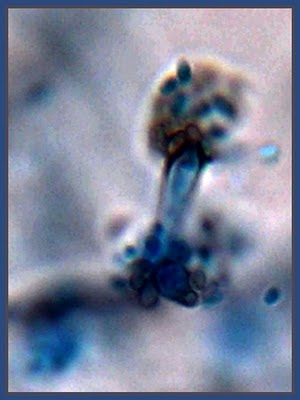Fungus (Black Mould)
One of the agents responsible for chromoblastomycosis, a slow moving fungal infection of the skin and subcutaneous tissue, usually initiated a splinter or thorn. A cosmopolitan saprobe commonly isolated from soil and decomposing wood. This infection is more common in tropical or sub-tropical climates where it can difficult to treat but is rarely fatal.
Other agents causing chromoblastomycosis are;
-Fonseca pedrosoi
-Cladosporum carrionii
-Fonseca compacta
Growth;
Exhibits slow to moderate growth, usually maturing in about 7 – 12 Days.
Macroscopic Appearance;
Colonies are woolly to velvety, dark grey, brown or olivacious black on the surface and reverse.
Microscopic Appearance;
Dematiacious (melanin pigment) - Hyaline to brown, septate hyphae.
Phialides are pale brown to brown, bottle or vase or shaped with a darker collarette at the apical end. Phaialides are located laterally or terminally on the hyphae.
Conidia are unicellular, smooth and thin walled, hyaline to brown and round or ovoid (1-3 X 2-4 µm) which accumulate at the apex of the collarette giving the appearance of a vase of flowers.

In chromoblastomycosis (histologic specimen), the organisms appear as dark round cells (copper pennies) 5 – 12 µm dia.
Phialophora verrucosa is distinguished from other fungi by its unique phialides with their collarettes. The shape of the collarettes themselves distinguishes Phialophora verrucosa from Phialophora richardssiae, the former being cup shaped, the latter having a flatter, saucer shape.

 Vase shaped phialides with round to oval conida at apex. Dark brown (containing melanin) cup shaped collarette at apex. Hyaline to brown (dematiacious ie. containing melanin), septate hyphae,
Vase shaped phialides with round to oval conida at apex. Dark brown (containing melanin) cup shaped collarette at apex. Hyaline to brown (dematiacious ie. containing melanin), septate hyphae, Ditto
DittoTo compare to Phialophora richardsiae (now known as Pleurostomo richardsiae) click Here.


















.jpg)























